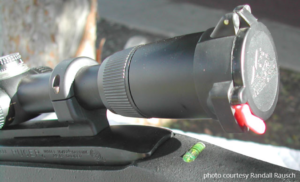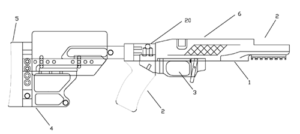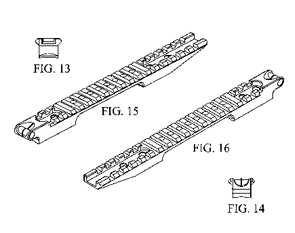By Ben Langlotz
|
September 7, 2017
|
Firearms, How To, Intellectual Property Advice, Patent
|
0 Comments
How To Kill A Patent

Unpatented but Legally Potent
It all started when I was on Facebook, innocently minding my own business. OK, as usual I was actually minding everyone else’s business on Facebook. Sometimes, when Karmen hears me typing furiously in the next room she calls out: “Honey, is someone wrong on the Internet again?”
I have a zillion Facebook friends in the industry, so I sometimes catch wind of new trends before things go viral. On one recent day, it was a post about a gun company that sells stocks with an embedded bubble level to help avoid aiming errors caused by a rifle canted from vertical. The company (which will remain nameless mostly because I’ve mellowed in my advancing years) had posted a legal warning message that was alarming some of their potential customers. Now, I admired the fact that they listed their patents on their bubble level innovation but I was startled at the tone of the warning:
“If you purchase a chassis/rifle with an embedded cant indicator level from a source other than (us)…it is not authorized by (us) and you may be liable for infringing (our) patents. If you infringe (our) patents, you may be responsible for paying money damages, enjoined from using the chassis/rifle you purchased, and even required to pay (our) attorney fees spent enforcing (our) rights against you.”
Not exactly the soft sell. I’m often an advocate for innovative marketing techniques that separate you from the competition, but “Buy ours or we’ll sue you” is a tad too much even for me.
Normally, when patent issues come up on social media, I might step in and ask someone to post the number of a patent they’re bragging about (often it turns out they don’t actually have one). I might take a look at a patent to see if it really covers what someone thinks it does. I might even send a note to someone if I think they need my services. But I usually won’t spend hours in deep research just to be a smarty-pants on the Internet.
However, in this case it so happened that I already knew about this patent. I knew a LOT about it. I had recently analyzed it deeply on behalf of a client who was worried about it. This, by the way illustrates my usual answer to the frequently-asked question: “Are patents worth anything if you aren’t willing to spend a million dollars to sue someone?” The patent owner never knew that my client was worried about their patent, and was considering changes to their design or business strategy just to avoid infringement. Patents sometimes work well without their owners even being aware of it, like the mugger who avoids the guy with the confident stride and bulge at his hip.
How To “Design Around” A Narrow Patent

Patented Product
The people who say: “You can get around any patent if you try hard enough” are wrong. But they are right sometimes. My job is to determine whether someone should be afraid of being sued under the patent.
The first step is that we compare the “accused” product (what my client wanted to produce) with the claims of the patent. To orient ourselves, this is one of the patent drawings and the key claim:
1. A rifle used by a shooter having stock section housing a firing pin assembly, a grip section, an action receiver, a barrel with a centerline axis and a cant measuring device comprising:
a) a solid block having a front side facing toward the rear of the action receiver, a back side contacting the rifle’s stock section, a bottom side contacting the rifle’s grip section and left and right sides parallel to the centerline axis of the barrel;
b) a tubular cavity bored within the solid block having a center that intersects the vertical plane of and is perpendicular to the centerline axis of the barrel having a first end open on one side and a second end closed on the other side of the solid block;
c) a top side having a view port created by removing material from the solid block such that the cavity can be viewed by the rifle’s shooter;
d) a bubble level inserted into said cavity such that when the rifle’s grip section is perpendicular to the centerline axis of the barrel, the center of the bubble is aligned with the centerline axis of the rifle’s barrel such that the bubble moves perpendicular to the centerline axis of the barrel as the rifle is rotated about the centerline axis of the barrel.
To infringe this claim, a device must have each and every feature and element of the claim. Omit one aspect and you don’t infringe.
When I look at a case like this I look for the key point of novelty, because most of the claim will be conventional elements that are common to most rifle stocks. In this case, I’ve highlighted a couple items that could be narrow limitations that give others a chance to avoid the patent without creating a substandard competing product.
In this instance, I’ve pointed out three elements of the claim that present opportunities to avoid the patent. There are more, but I’ll keep it simple in this brief analysis:
1. Left and right sides (of the stock portion that holes the bubble level) parallel to the centerline axis of the barrel. This can easily be avoided by making your stock sides tapered, or rounded. Easy.
2. A tubular cavity bored within the solid block…having a first end open on one side and a second end closed on the other side. This is avoided by making the second side open, such as having a little vent hole in the bore. And there may be something to the “bored within” language because that implies only cavities made this way infringe. What about if the cavity were molded into the stock?
3. A view port created by removing material from the solid block. Again, there is a manufacturing method limitation that can be avoided by molding or forging the port instead of removing material.
Remember that to avoid the patent, you need to eliminate only one of these features. But I often advise clients that if they lack two features of the claim then that is better “belt and suspenders” protection that makes them an even less tempting target to the patent owner and the lawyers advising them.
That’s how you “Kill” a patent by finding its weaknesses and designing around them. And it’s important to note that when drafting patent claims for my own clients I will do my best to ensure that we don’t have needless narrow limitations. Sometimes they are necessary to get the patent, but we work to get the broadest justifiable protection available. In this case, my review of the publicly-available “file history” revealed that not all of these limitations were really needed to win the patent, and I wonder if lack of firearms expertise by the patent attorney led to unknowing inclusion of unimportant limitations like these.
By the way, that picture on the cover this month is not the patented product, or the product of anyone worried about being sued under the patent. It’s the work of gun hobbyist Randall Rausch, and I’m publishing it with his permission. You see, Randall decided to stop gluing bubble levels onto his stocks in 2009, when he realized that carving out a pocket and embedding them made more sense. That’s more than three years before the questionable patent application was filed. And the poor overworked and under-informed patent examiner had nothing before him to suggest that a bubble level had ever been embedded in a stick like this before. “Smoking-Gun Prior Art!”
How To Kill A Patent You DO Infringe
If a patent claim is too broad to avoid, we can sometimes find other ways to “kill” it. The first is to find prior art (pre-existing technology) that the patent examiner didn’t know about, and would have used to reject the patent. Often, simply letting a patent accuser know that you know that the “smoking gun” document was never disclosed to the patent examiner will make them back off fast. There are Patent Office procedures for invalidating a patent without an expensive lawsuit, and even if the patent owner sues, the judge in that case will suspend action until the Patent Office makes their ruling. That’s because judges tend to trust the technical patent experts in the patent office to make these kinds of determinations. A patent owner will often back off because even by avoiding your invalidation threat they may get some value from owning the patent.
In this case, there’s another patent claim to analyze – note that they only need to show you infringe one claim to shut you down or collect damages. This is a claim that seemed so broad my instinct said it can’t possibly be valid. It’s a claim to a method of using a rifle with a bubble level:
A method of compensating for the cant of a rifle having a barrel and receiver, a scope or other reticle sighting means, a stock and a bubble level embedded into the stock having a center line mark that is in line with the axis of the barrel, the method comprising:
a) Identify a target and its proximate distance from the rifle,
b) Align the sight reticle in accordance with the proximate distance to the target;
c) Glance down from the eyepiece of the reticle to assess the degree of cant to the rifle by noticing the left or right deviation of the embedded bubble level as shown by the misalignment of the bubble relative to the center line mark;
d) Rotate the rifle about the axis of the barrel such that the bubble in the embedded bubble level aligns with a centerline mark;
e) Recheck the alignment of the sight reticle relative to the target; and
f) Recheck the rifle cant and rotate the rifle about the axis of the barrel to ensure the bubble level is aligned with the center mark.
Basically, they’re claiming the process of aim-tilt-aim-tilt. Which is possible for any bubble level of the

The Prior Art
types that have been used for generations. This just feels like it isn’t enough for patentability. So, when I looked at the examination history, I found that the claim had been rejected, but the patent attorney argued strenuously that the whole point was that the shooter could keep his eye in position, and it’s all about the term “glance,” which implies no head movement. The lawyer argued in writing to the examiner to avoid a rejection based on a scope mount rail that had a bubble level at
its rear end:
“Placing the bubble level on the scope mount fixture requires additional movement of the shooter’s head to see the bubble level. Applicant’s location requires the shooter merely to point eyes downward from the eyepiece of the scope. The cant indicator location of (the prior art) would require additional movement of the shooter’s head relative to viewing the eyepiece of the scope.”
That was enough to win the heart and mind of the examiner, and the patent was granted. But there’s now one little problem: What the attorney argued simply wasn’t true. The prior art “Bubble Rail” (the brand name I’d give it) actually gives the same benefit of letting the shooter maintain his cheek weld while glancing at the level. Here’s how I know: The owner of the prior art patent makes and sells these bubble rails, and markets them by touting this advantage:
“When using the (Prior Art) Scope Base, your level and scope eye piece are in the same sight picture. This allows you to check the level while aiming without having to raise your head from the shooting position.”
It’s likely the patent attorney was ignorant of this info about the prior art when he made the false arguments, but if the patent were ever litigated the defense would have a field day with “fraud” and “deception” in hopes not just of winning but collecting some attorney fees. A judge might be more generous with damages as well.
Lessons Learned
Decades ago, a patent litigator taught me that a patent attorney needs to understand how patents can be attacked to be able to write good patents that withstand these attacks. My goal is to write patents that withstand these challenges.
With my mechanical engineering and firearms expertise, I may be able to suggest simple design changes that can help avoid the risk of infringement accusations. That kind of knowledge is also helpful when negotiating a license with a patent owner, because we can point out the non-infringing options we have as an alternative to paying excessive royalties.
So, if you’re threatened with patent infringement, or if you’re worrying about stepping too close to a patented competing product, call me to have us to conduct at least a brief analysis of the risk level.